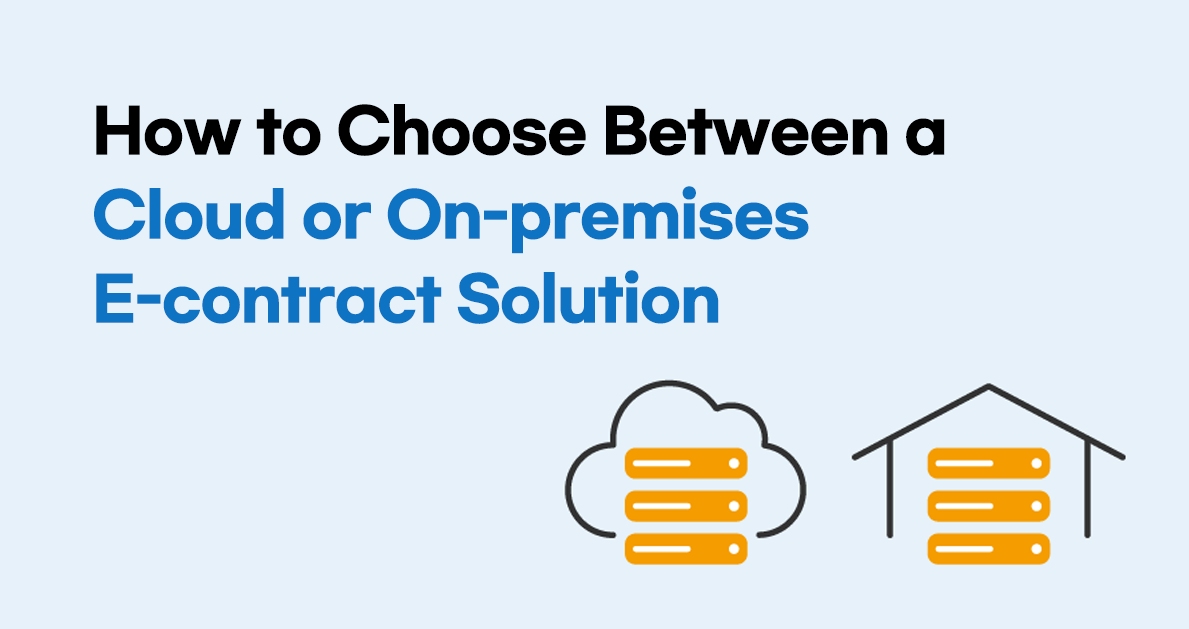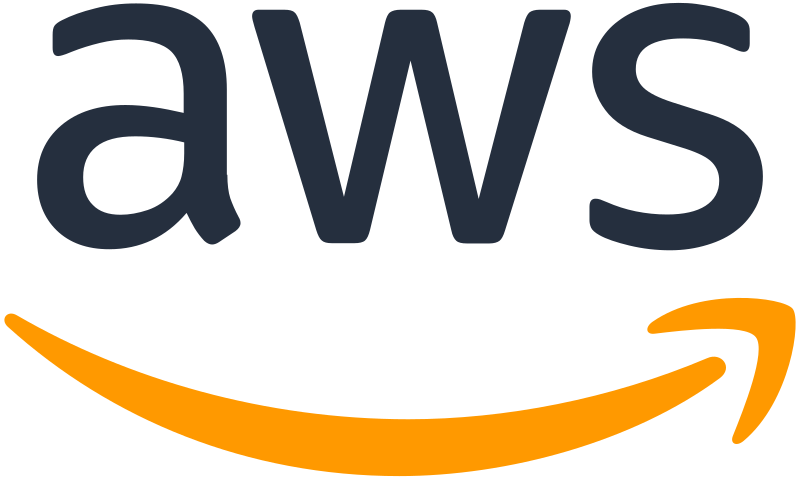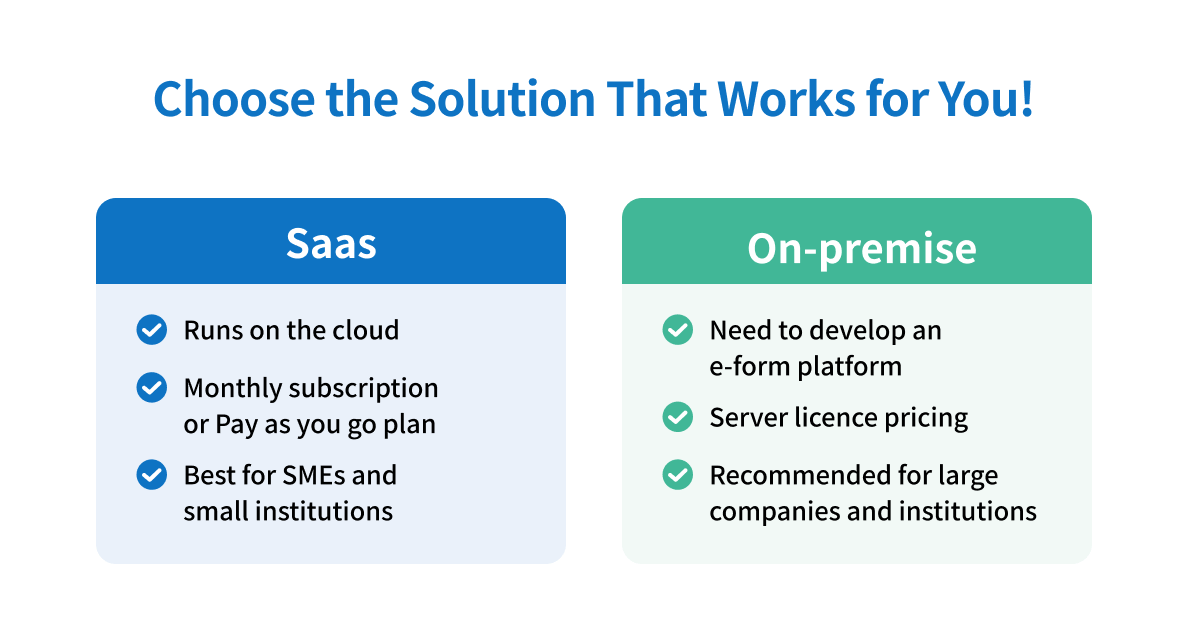
As digital transformation sweeps across businesses and public institutions, the choice between cloud and on-premises e-contract solutions has become a pressing topic. With the shift towards digitalization, particularly through software services like electronic contract platforms, understanding the key differences between cloud and on-premises solutions is more important than ever. This post aims to help you navigate this crucial decision.
While many companies are migrating from on-premises setups to cloud environments, this doesn’t necessarily mean the cloud is the right fit for everyone. The real question isn’t which option is universally better, but which one aligns best with your specific needs. Every organization has its own unique combination of budget, resources, and operational processes, so the ideal solution will depend on these factors.
At the core, cloud and on-premises solutions differ in how they manage the IT resources necessary to deliver software services. Whether they are servers, storages, or networks, the distinction lies in who controls these resources and how they are deployed.
🏠 On-premises
On-premises solutions involve a company setting up and managing its servers on its own physical hardware. This approach was the standard before cloud computing became mainstream, requiring businesses to build and maintain their own IT infrastructure. Unlike cloud solutions, which operate in a virtual space, on-premises systems demand that companies purchase hardware and software outright and manage everything in-house.
☁️ Cloud
As IT systems become increasingly complex, managing the necessary infrastructure—such as servers, networks, and storage—can become a significant challenge, often leading to higher costs and inefficiencies.
Cloud computing offers a streamlined alternative. By enabling companies to access only the IT resources they need through the internet, cloud solutions can significantly reduce the burden of managing physical infrastructure. Cloud services fall into three main categories, each offering distinct benefits:
- Software as a Service (SaaS): SaaS allows users to access software directly via a web browser, without the need for installation or ownership. Examples include Google Drive and Gmail. SaaS was the first cloud service model to gain widespread popularity and includes tools like eformsign for electronic contracts.
- Infrastructure as a Service (IaaS): IaaS enables businesses to rent virtual servers and data storage over the internet, eliminating the need to invest in physical data centers. Netflix, for example, uses Amazon Web Services (AWS) to deliver high-speed video streaming worldwide.
- Platform as a Service (PaaS): PaaS provides a comprehensive platform for software development, offering all the necessary tools and environments without requiring developers to set up their own infrastructure. Google App Engine is a prime example, offering a robust environment for seamless application development and deployment.
Leading Cloud Service Provider: AWS (Amazon Web Services)

AWS is the trailblazer in the global cloud computing market, holding a commanding 33% market share. Known for its cutting-edge cloud functionalities and reliable services, AWS continues to innovate and lead the industry.
AWS offers a broad range of features, including computing, storage, and databases, serving over a million customers in more than 190 countries. Major global companies like Netflix, Adobe, and Airbnb, as well as top Korean firms like Samsung Electronics, Hyundai Motor, and LG Electronics, rely on AWS for its security and stability. eformsign also stores its data on AWS, benefiting from a secure data storage environment and holding the AWS Certified Software badge.
Comparing Cloud and On-Premises Solutions
When deciding between cloud and on-premises solutions, consider the following factors in terms of cost, security, and management:
| Factor | Cloud | On-premises |
| Cost | No initial investment; subscription or pay-as-you-go pricing; additional costs as data usage increases | High initial setup costs; fewer additional costs related to data; potentially more cost-effective long-term |
| Security | Security systems provided by the cloud service provider | Security systems implemented by the company itself |
| Deployment and Management | Rapid deployment; no need for dedicated management personnel | Requires additional time for system setup; customizable; requires dedicated management personnel |
In summary, if your organization plans to use the system long-term, has specialized personnel to manage it, and needs dedicated servers exclusively for internal use, an on-premises solution might be the best choice. However, if initial setup costs are a concern, if allocating dedicated operational staff is difficult, or if you need a quick deployment without building your own servers, a cloud service may be more suitable.
✔️eformsign: An E-Contract Solution for Both Cloud and On-Premises Environments

eformsign supports both cloud and on-premises solutions, catering to a variety of business needs. For small and medium-sized businesses or organizations that find initial setup costs burdensome or lack the staff to manage server infrastructure, the SaaS-based cloud service is recommended. Conversely, for public institutions, large corporations, or financial institutions that manage their own security systems and have dedicated personnel, an on-premises solution is a better fit.
What sets eformsign apart from other electronic contract services is its ability to support both approaches, thanks to proprietary technology. For the on-premises solution, eformsign assigns a dedicated representative to analyze your environment and provide a customized quote. This solution not only offers reasonable implementation costs based on server licensing but also ensures continuous updates, overcoming the common limitations of traditional on-premises systems.
To learn more about eformsign, click the buttons below.

